Set up
1. A-frame position
2. Straight bottom arm
3. Comfortable rotation of shoulders
4. Comfortable rotaion of hips
5. Top arm over water
6. Appropriate top arm bend
Catch
1. Continue to extend forward with bottom shoulder while dropping to water
2. Catch water without "air catch"
3. Blade moves forward into water
4. Save rotation - keep top shoulder back
5. Stabilizing pressure from top hand
6. Shoulders stacked - weight goes on paddle as opposed to board
7. Initiate pull with hips
Pull
1. Downward pressure from top hand
2. No forward punch with top hand
3. Save rotation - keep top shoulder back
4. Bottom arm stays straight
5. Body weight loaded on paddle - shoulders stacked
6. Paddle buried - deep, connected stroke which is a "quiet stroke"
7. Neck relaxed, shoulders low and relaxed
8. Top hand stays high
9. Top hand push down on paddle into a sit-up in second half of pull - "grow over paddle" or "pole vault"
10. Shoulders unrotate simultaneously with sit-up
Exit
1. Top hand at eye level and initiate exit
2. Top hand rotates slightly inside board to move blade away from board
3. Thumb of bottom hand turns to hip; exit sequence of wrist, elbow, shoulder - not a "choo-choo train" using biceps
4. Exit cleanly - "draw sword from water" Top hand about 11 o'clock for R and 1 to'clock for L
5. Shoulders stay low and relaxed; neck relaxed
Recover
1. Arms extend in front of you
2. Relaxed; "floating on air" feeling
3. Motions on board are cat-like and do not disrupt board glide
4. Heels light on board as you move forward
| |
|
| |
The Basic Power Stroke
|
| |

|
| |
It is important to get the board moving before you start to use a power stroke, so this basic power stroke is in the forward facing position with your feet parallel. Start by doing 2 or 3 short soft strokes then angle your body more forwards so you can place the blade further forwards.
|
| |
It is important not to bend to much at the waist, as in 1).
Once the blade enters the water both arms should be straight and the paddle should be vertical in the sideways plain, as in 2).3) and 4) are the same movement as in the first stroke you learnt.
However you should try and have the same pressure on each arm.
So the more power you put into moving the bottom arm back the more power you have to put through the top arm.As you get to 5) you should be moving your hips forwards and taking the power out of the stroke.6) and 7), you are rolling the wrists forwards and taking the paddle out of the water.
As you bring the blade forwards, keep it low to the water and aerodynamic.
|
| |
|
| |
POWER STROKE IN THE STEP POSITION
|
| |
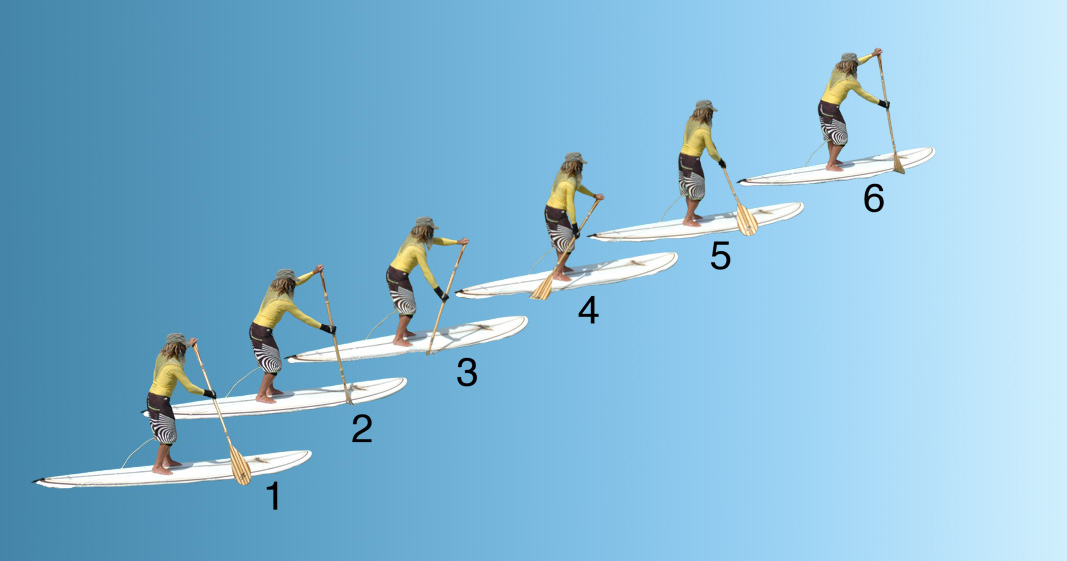
|
| |
Once the board is moving faster you can stagger the feet a bit to get even more power into the stroke.
You will also be making shorter and faster strokes.
We have the paddle on the right side in 1), so it is the left foot that goes slightly forwards.
So when you change the side of the paddle the feet must change.
You can see in 2) that as the blade goes into the water the hips move down placing the blade deeper into the water, giving more power.
So with this technique you are going to need more strength.
As the blade comes back, you are moving your hips forwards and up in 3).
You can see in 3),4),5) that the release is faster as you bring your body up and forwards ready for the next stroke in 6)
|
| |
|
| |
STEP TURN
|
| |
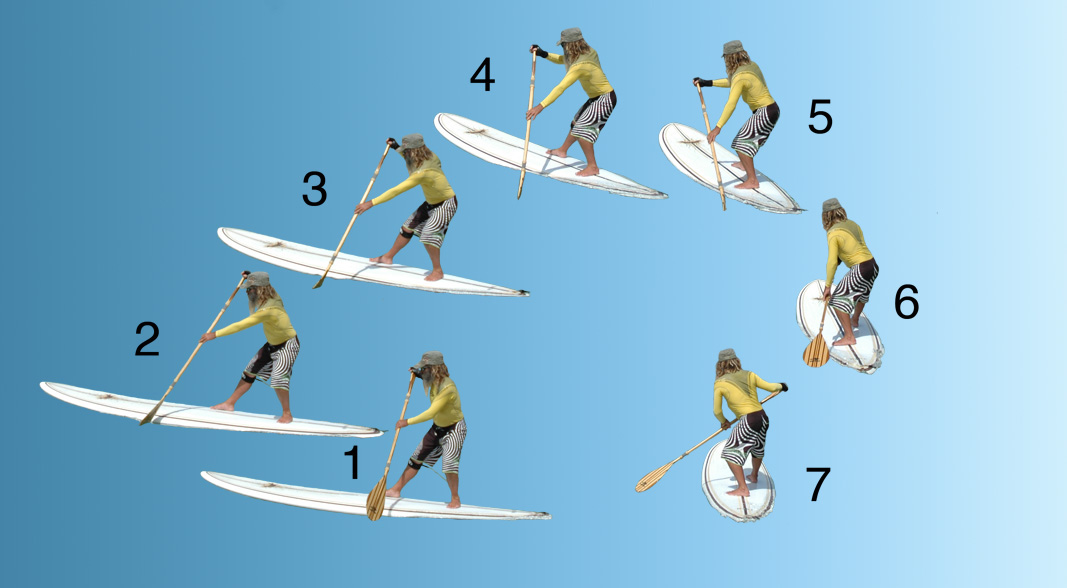
|
| |
When you are first learning this maneuver it easier to do it from the step power stroke with forward momentum.
As you finish the power stroke and start to bring the paddle forwards, move your back foot further back, as in 1).
It is important at this stage to keep your body weight forwards.
Reach forward with the bottom hand and place the blade in the water close to the board as in 2).3).
As you bring the paddle back move it away from the board and transfer your weight onto the back foot.
Once the blade reaches your front foot, it should have reached the furthest away from the board.
You now start to bring the blade to the back of the board, as in 4).
The tail will start to sink rapidly so control the amount of sink by transferring weight onto the front foot.
You can see in 5) that the back corner of the board catches as the blade gets closer to the board. This stage is very unstable so make sure you keep your body weight over the centerline of the board.6).
Once the blade reaches the back of the board, roll your wrists forward which will help to bring the blade out of the water.Now transfer your weight onto your front foot to level the board off and bring the blade forwards to start another stroke
|
| |
|
| |
STEP REVERSE TURN
|
| |
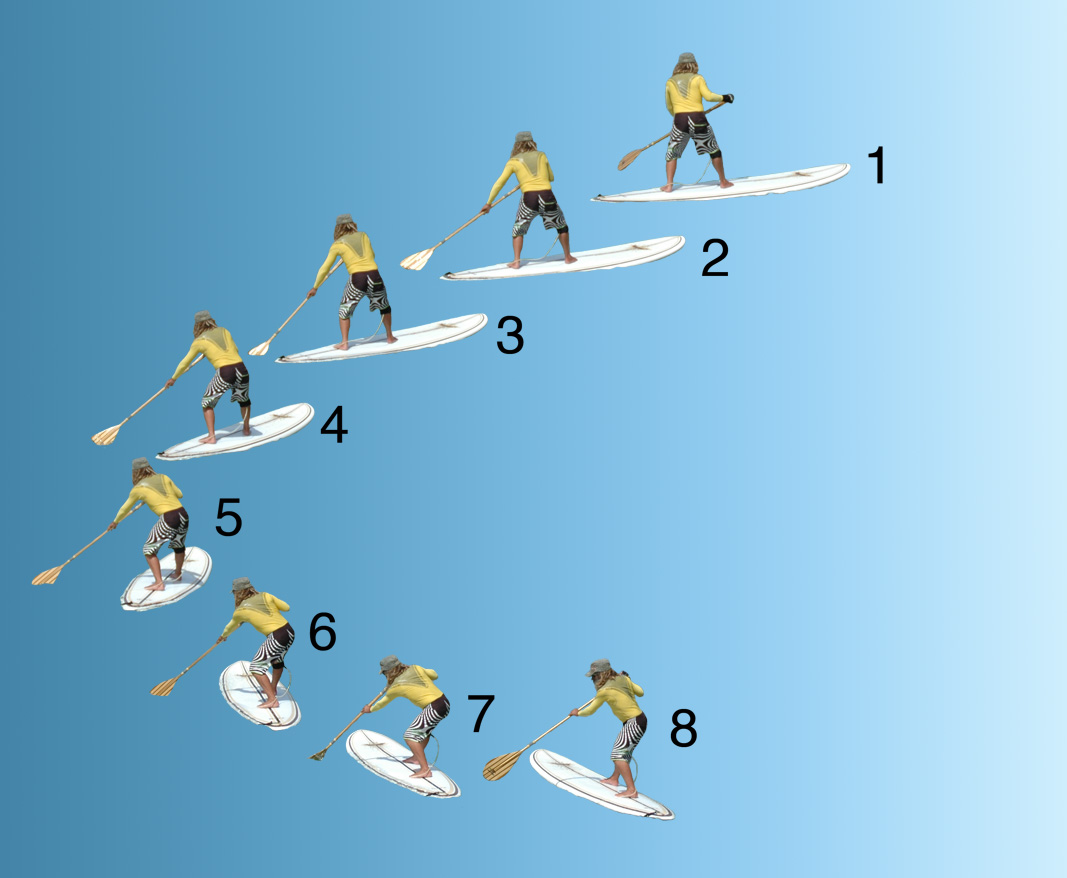
|
| |
Where as in Getting started this was an easier way of turning around, once in the step position it is much more difficult than the forward step turn.
There are many things to watch out for.
Like in the step turn you move the foot back from the step paddle stroke, making sure that the back foot is over the centerline of the board as in 1).
You then rotate your shoulders so you are parallel to the board and straighten your bottom arm, placing the blade in the water at the back of the board.
The moment the blade goes into the water the board will start turning as in 2).
Now this is the first tricky part. Depending on how fast you are traveling and how much pressure you put into sweeping the blade forwards, determines the speed of the turn.
In 3). and 4). you have to make sure the board stays flat.
So pressure on your heels and the front foot is important. Also as you sweep the blade you are rolling your wrists forwards.
Once at 5). the blade is at it’s furthest distance from the board and care must be taken with the balance.
Even though you are now moving the paddle in front of you be careful that the tail does not sink.
At 6). you can bring the paddle out of the water so you do not stretch to far but the further you go to the front the more the board turns, as in 6). 7) and 8).
|
| |
|
| |
THE SINK TURN OR SNAP TURN
|
| |
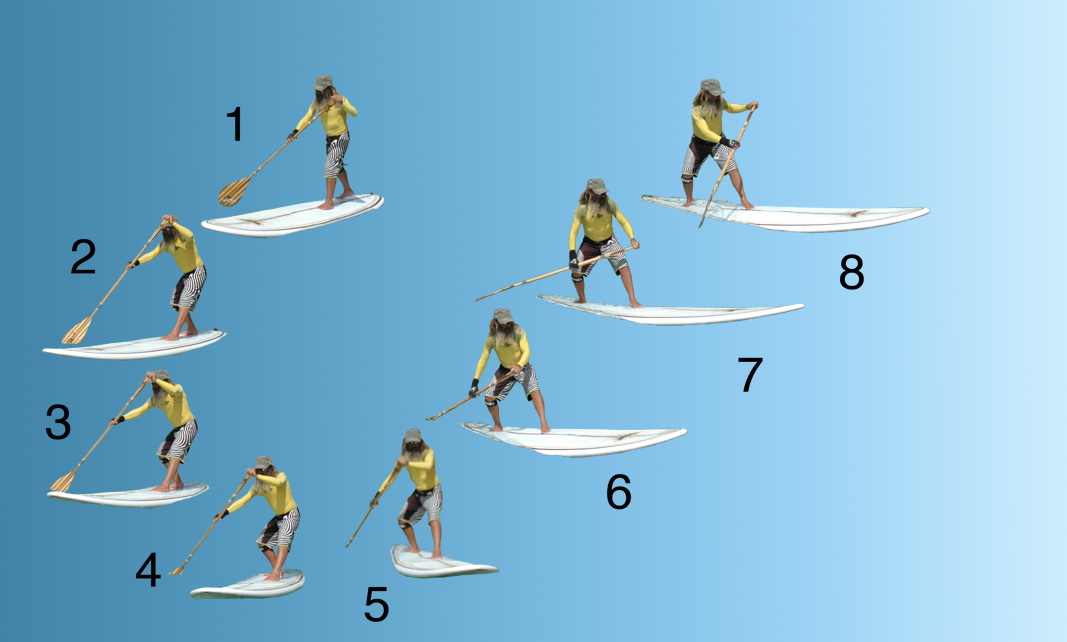
|
| |
This is exactly the same as a step turn in technique.
However there are subtle changes.
It can be done both from a stand still or from a step power stroke.
The diagram is from a stationary start, so a sink turn.
When it is from a step power stroke it is a snap turn.
You can see in 1). that the blade is already forward when I am stepping back.
The feet are over or near to the centerline of the board and my body is over the centerline of the board.
As you move back the weight must be over the front foot.
For a sink turn this stage is very delicate and you must be ready for step 2). quickly. in a snap turn it is not so important as you have forward momentum so the tail will not sink so fast.
In 2). you must co-ordinate the weight on your back foot with the draw stroke, it must be at the same time. If not the tail will sink to fast. In a snap turn you sink the tail to stall the board.
In 3). and 4). the draw stroke will support your body weight, so you control the amount of sink by changing the pressure on your back foot.
Once the blade goes past your feet it is coming back into the board which drags the tail under water.
In 5). you must transfer your weight onto your front foot.
6). Is the most unstable part of the turn as the blade is right at the back of the board.
Roll your wrists forward to make the blade flat on the water, where you can put a bit of weight on the paddle to get your balance back, just before bringing it out of the water.
Try to make this movement as smooth as possible.7). and 8). you have all your weight on the front foot and bringing your body up over the front foot.
|
| |
|
| |
ADVANCED SUPPORT STROKE
|
| |
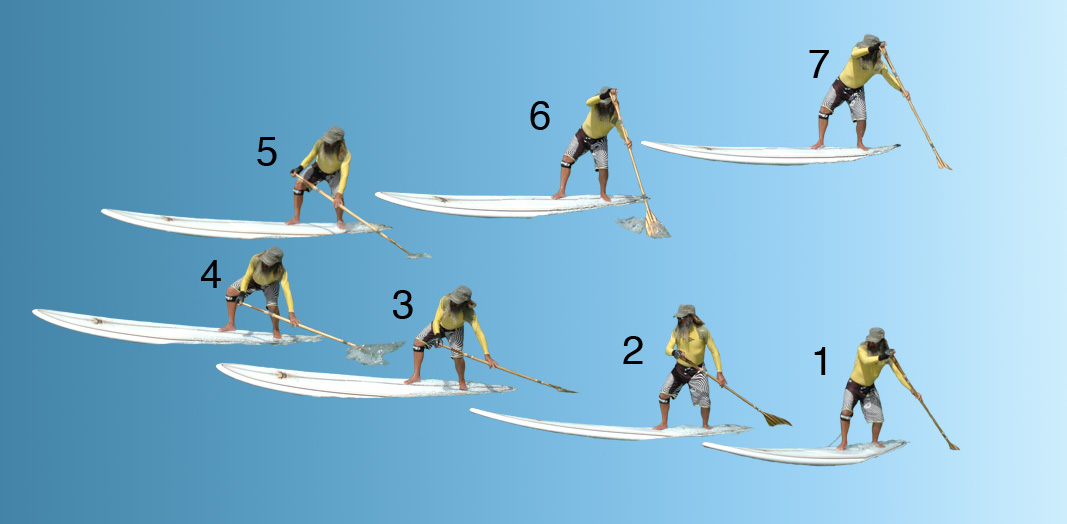
|
| |
In this example we are looking at it from the end of a sink/snap turn.
As mentioned when the blade is drawn into the back of the board the tail sinks and the board is very unstable, so a support stroke is often needed.
In 2). 3). and 5). you roll your wrists forwards to make the blade flat on the water and sweep it forwards, putting pressure on it to regain your balance.
This should be enough but if you have not regained your balance the initial movement you must roll your wrists back and change to using the other side of the blade, as in 5).6) and 7).
You are drawing the blade back to the back of the board.
Notice the blade does not come out of the water.
You can repeat this sequence until your balance returns.
|
| |
|
| |
ADVANCED STEP TURN
|
| |
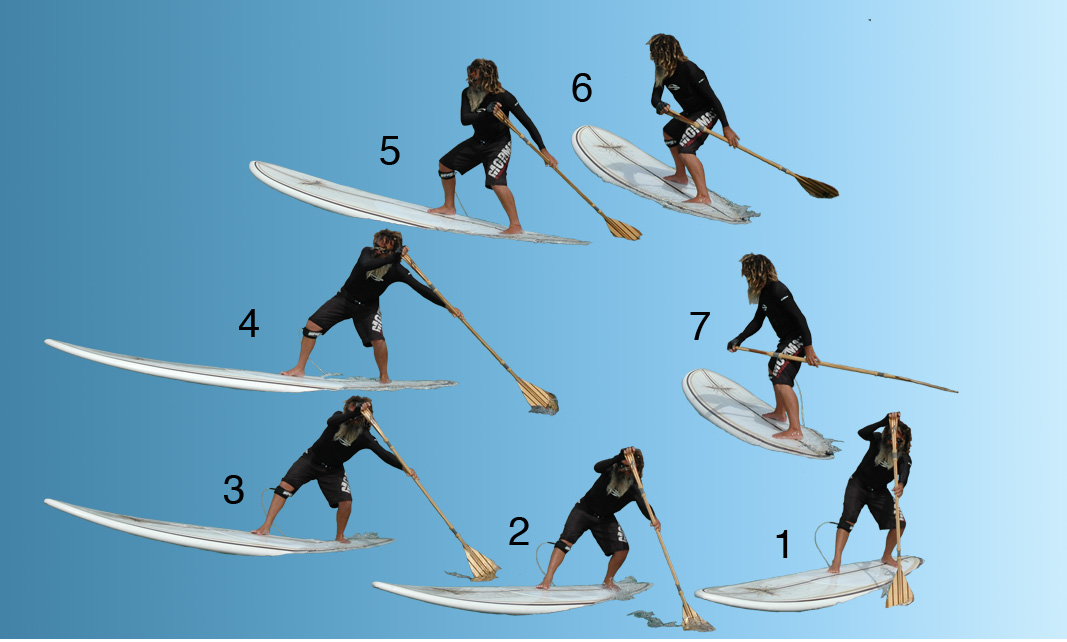
|
| |
The main difference with this turn is that you are further back and giving more power, plus the sweep is going way past the back of the board.
You start the stroke level with your front foot as in 1).
It is not so important to take the blade a long way out as the power is put into the sweep across the back of the board, as in 3).4).and 5).
It is important to keep your body over the centerline of the board and to regulate the amount the board sinks by transferring your weight between your front and back foot.
You can see in 6). to keep your balance it helps to keep your body weight low.
It is possible to turn more than 180º with this turn.
So it is very useful when surfing.
So this brings us to the end of Getting the power.
Its the time to go onto the next section.
Steering and correction strokes.
So we must learn to create more power, which does not mean more strength isneeded.
You will notice that for most movements we will be discussing, you still don’t need to grip the paddle firmly.
|
| |
|







